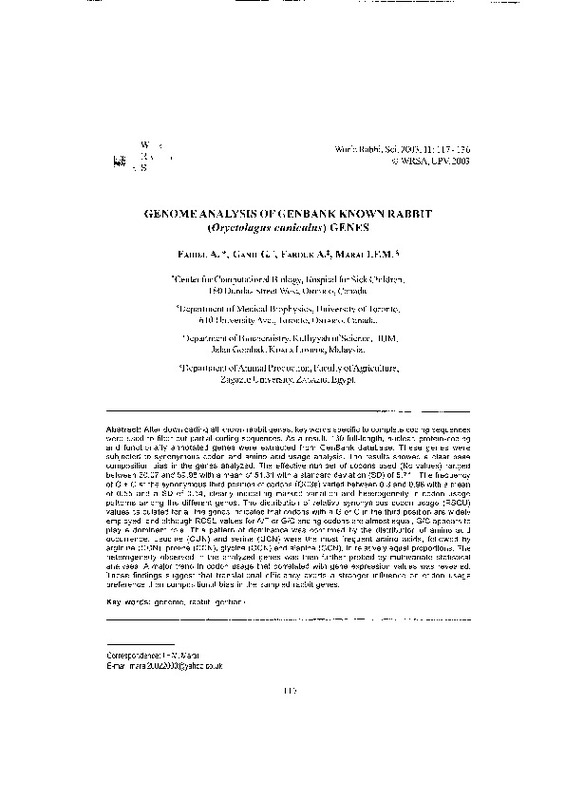JavaScript is disabled for your browser. Some features of this site may not work without it.
Buscar en RiuNet
Listar
Mi cuenta
Estadísticas
Ayuda RiuNet
Admin. UPV
GENOME ANALYSIS OF GENBANK KNOWN RABBIT (Oryctolagus cuniculus) GENES
Mostrar el registro sencillo del ítem
Ficheros en el ítem
| dc.contributor.author | Fadiel, A.
|
|
| dc.contributor.author | Ganji, G.
|
|
| dc.contributor.author | Farouk, A.
|
|
| dc.contributor.author | Marai, F.M.
|
|
| dc.date.accessioned | 2011-02-23T10:23:55Z | |
| dc.date.available | 2011-02-23T10:23:55Z | |
| dc.date.issued | 2003 | |
| dc.identifier.issn | 1257-5011 | |
| dc.identifier.uri | http://hdl.handle.net/10251/9939 | |
| dc.description.abstract | [EN] After downloading all known rabbit genes, key words specific to complete coding sequences were used to filter out partial coding sequences. As a result, 160 full-length, nuclear, protein-coding and functionally annotated genes were extracted from GenBank database. These genes were subjected to synonymous codon and amino acid usage analysis. The results showed a clear base composition bias in the genes analyzed. The effective number of codons used (Nc values) ranged between 30.07 and 59.98 with a mean of 51.31 with a standard deviation (SD) of 5.71. The frequency of G + C at the synonymous third position of codons (GC3s) varied between 0.3 and 0.96 with a mean of 0.55 and a SD of 0.14, clearly indicating marked variation and heterogeneity in codon usage patterns among the different genes. The distribution of relative synonymous codon usage (RSCU) values calculated for all the genes indicated that codons with a G or C in the third position are widely employed, and although RCSU values for A/T or G/C ending codons are almost equal, G/C appears to play a dominant role. This pattern of dominance was confirmed by the distribution of amino acid occurrence. Leucine (CUN) and serine (UCN) were the most frequent amino acids, followed by arginine (CGN), proline (CCN), glycine (GGN) and alanine (GCN), in relatively equal proportions. The heterogeneity observed in the analyzed genes was then further probed by multivariate statistical analyses. A major trend in codon usage that correlated with gene expression values was revealed. These findings suggest that translational efficiency exerts a stronger influence on codon usage preference than compositional bias in the sampled rabbit genes. | es_ES |
| dc.language | Inglés | es_ES |
| dc.publisher | World Rabbit Science. ICTA. UPV | es_ES |
| dc.relation.ispartof | World Rabbit Science | |
| dc.rights | Reserva de todos los derechos | es_ES |
| dc.subject | Genome | es_ES |
| dc.subject | Rabbit | es_ES |
| dc.subject | Genbank | es_ES |
| dc.title | GENOME ANALYSIS OF GENBANK KNOWN RABBIT (Oryctolagus cuniculus) GENES | es_ES |
| dc.type | Artículo | es_ES |
| dc.date.updated | 2011-02-23T09:38:02Z | |
| dc.identifier.doi | 10.4995/wrs.2003.502 | |
| dc.rights.accessRights | Abierto | es_ES |
| dc.description.bibliographicCitation | Fadiel, A.; Ganji, G.; Farouk, A.; Marai, F. (2003). GENOME ANALYSIS OF GENBANK KNOWN RABBIT (Oryctolagus cuniculus) GENES. World Rabbit Science. 11(3):117-136. https://doi.org/10.4995/wrs.2003.502 | es_ES |
| dc.description.accrualMethod | SWORD | es_ES |
| dc.relation.publisherversion | https://doi.org/10.4995/wrs.2003.502 | |
| dc.description.upvformatpinicio | 117 | |
| dc.description.upvformatpfin | 136 | |
| dc.description.volume | 11 | |
| dc.description.issue | 3 | |
| dc.identifier.eissn | 1989-8886 | es_ES |








